This week’s topic about the dual coding theory and Mayer’s cognitive theory of multimedia learning was somewhat close in the sense that both assumptions signify on eyes and ears; however, the latter theory states that the previous information is profound while the former never says that. Mayer claims that twelve multimedia learning principles are efficient when coding pieces of information into our brain. To explain, the principles are categorized into three separate groups: reducing, managing, and fostering. Since human brains do not work like artificial intelligence or computer, it is nearly impossible to absorb a bazillion of information at once. Hence, reducing the amount of input will help us to memorize things (reducing extraneous processing). Students can understand course materials or the lecture by learning the key terms beforehand (managing essential processing). Not only teaching materials by words and graphs but demonstrating how it works(fostering generative processing).

I agree with Mayer’s twelve princes in terms of shortening the time to input the information and the overall efficiency. I have used some of the strategies during my high-school years. But my consideration towards this theory has changed over time, especially at the starter of my college year. I always thought that just inputting the essential terms or phrases brings me academic success; however, outputting is equally or even more valuable to understand the course from the fundamental aspect. I believe that Mayer’s principles theory is a genuine tactic to memorize things and should be adjusted into modern style.
Here is my sketch-note for this week’s material.


Anum
Hi Atomu,
Thank you for sharing your thoughts on Mayer’s 12 multimedia principles. I like the blog and your sketch note.
Something I am wondering after reading your post is to modify my sketch notes for upcoming blogs using the segments.
Looking forward to your next blog!
Thanks,
Anum
atomin
Hi Anum,
Thank you for your comment and compliments about my sketch note. I will do my best to modify your future sketch note, although your illustration looks much clear and artistic. If there’s an opportunity, I will be happy to create blog posts with you or work on the upcoming group project.
Again, thank you!
Atomu
邦妮
Hi Atomu,
Thank you for sharing. I think you have a very thorough understanding of what we learned this week. Through your first paragraph of summary, I have a clearer understanding of the knowledge. I should learn this ability from you !
Bonnie
atomin
Hi Bonnie,
Thank you for your comment about my writing, although I believe some parts are not palpable and eloquent. I have read your post and sketch-note, which I really liked in terms of how you organized and segmented each definitions using different colours. I learned how it is significant to categorize concepts with distinct tones of colours not only for wordings but illustrations from your sketch-note.
Again, thank you for your reply.
Atomu
queenieyao
Hi Atomu,
I love your sketch note and how you summarize the material. The structure of this blog is excellent. Thank you for sharing.